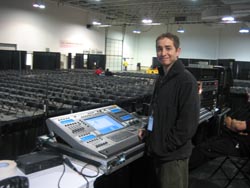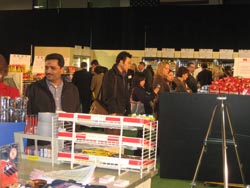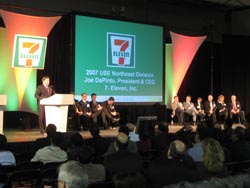- American Audio Visual Center (AAVC) out of Scottadale, AZ recently provided support for 7-11's annual roadshow, the University of 7-11. Now a yearly project for AAVC, the show is a multifaceted event that makes seven stops in the US, one in each region, and one stop internationally in Calgary, Canada. It's a chance for the company to get franchisees and store managers together to look at new products, for the CEO to speak with everyone, and also for some breakout training sessions.
American Audio Visual Center provided support for 7-11's annual roadshow. This single screen set was for the stop in Secaucus, NJ.
This year's roadshow was comprised of several breakouts, a mockup store with full inventory, a kitchen for preparing new foodstuffs, a wide array of booths with new product samples, and a general session. To provide support for such a diverse project, AAVC had to get a system down for setting up the gear in a timely fashion, while being able to adapt to the challenges each venues posed. The project manager for the show, freelancer Greg Edder, had worked on the project before and was aware of these issues when putting together the show. Edder recalled, "The adaptability was tough. In the general session room we had to be able to adjust to the size of the audience based on where we were. So we'd go from a single screen format at one venue to a double screen for a stop like Richmond where we had like 1000 people. And the venues we went into were quite different. Some would be high tech, like fully equipped ballrooms, and the others would be the bare minimum, like fair grounds. The challenge was maintaining the consistent level of presentation under the different variables posed by each location."The gear for the general session was very adaptable for the size of the audience. For audio, an EAW rig was used with KF 300Es, JF 80s, JF 200s, and SM 200Ls speakers. A Midas Venice 320 was used for control, as well as several Shure UHF wireless microphones, and a Shure MX418E podium mic. Edders explained the audio setup, "For audio, our guy would get different parameters each time. So he'd have to cover 700 for one gig, and 400 for another, and he'd have the same gear each time. It might be too much for one but just enough for another. Because of the budget and time we decided years ago to never fly anything on this show if we didn't have to, so we always bring enough for coverage."

Freelance lighting director Chris Velasco stands in front of his Jands Vista T2 board which he used for the roadshow.
For video, the 10.5 x 14 foot screen was projected onto by two Barco R6s, and the signal was controlled by a Folsom Screen Pro II. The roadshow provided several challenges for the staff, including the absence of a video specialist. Since the local labor that was provided at each venue was always different in terms of skill, the video rig had to be straightforward. Edders explained, "We didn't bring a video guy, so we had to make the video rig as foolproof as possible coming out of the shop so anyone could hook it up. That required a little more documentation. In this case we wanted to over label everything for people coming through. For the whole tour we had a lighting guy, an audio guy, and a technician to run all the breakouts. But fortunately, that extra guy was a good projectionist. So he was there for support at each stop. But we were very dependant on the quality of the local crews, and it does surprise you sometimes how much they vary."
Lighting was conventional for the general session, about 30 Source 4s, and the Jands Vista T2 for control, which the lighting director Chris Velasco had brought along to learn the intricacies of the board. However, 7-11 also requested that the mockup store have proper lighting, much like a real store, so Velasco was charged with that task. Unlike the previous year when AAVC used six Genie Towers to crank the lighting out for the store, this year they scaled back to four, causing Velasco to get creative. He used 38 Source 4 Parnels mounted on Par bars, and 48 Source 4 Pars as uplighting, controlled by an ETC 24 x 48. Velasco explained, "What we ended up doing to compensate was we added another 6 bar on the two front right lifts, to light the end caps of the aisles for the store. We also had to make an X pattern with the back towers, and did the best we could to light the back aisles. The front towers were more important as to lighting the more focused parts, like the cashier station. So we added two more bars for the front towers. And it was different at every venue. We had to work around columns and scoot these towers so we could angle them the best, it was quite a task."
For the breakout rooms, standard gear was used. The 6 x 8 foot screens were lit with Eiki LC0XG110s, and Extron VGA switcher was used for sources, a couple JBL Eons for sound, a Spirit Folio for control, and several Shure wirelesses for the various speakers.

AAVC helped 7-11 light their virtual store with the latest food offerings from the company.
Overall the roadshow was quite a success for AAVC and 7-11, and they will be supporting the event next year as well. Edders attributes the accomplishment to preparation. "We were working with a client who is very budget conscience. But I think this was a good example of providing a very scalable and adaptable show to meet the client's various challenges, while trying to keep a consistent product in multiple venues. As a freelancer I've been involved with this show for a couple years, and I think this was the smoothest and most trouble free year we've had. I believe it was because we used the experience of the past years to distill that concept of mobility and scalability, just refining it down to the simplest core." For more information visit www.americanavc.com.
Tales From The Road
Freelance lighting designer, Chris Velasco has been no stranger to the lunacy of the staging world. From unexpected glitches to missing gear, everyone in the industry has a story to tell. Here's Velasco's:
"About eight years ago I was working on a robotic lighting system in a small venue. This was around when I started doing lighting and was touring smaller venues. I was double checking the rig and being careful, but when I went down to get a tool some guy turned on the wrong switch while I was on the ground, powering up all my fixtures. So when I went back up and touched the inside of one of the moving fixtures, the igniter ended up arcing like a good three inches, and 40,000 watts shot right into my hand. It threw me off the 12-foot ladder across the venue, probably a good 25 feet, horizontally. Amazingly, the ladder stayed put, but my hair was smoking and my hands were black. That was over eight years ago and the tip of my pinky is still numb."
